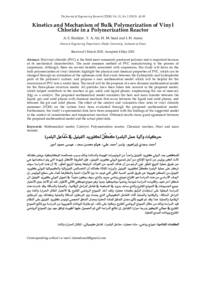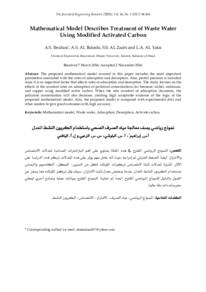وثيقة
Kinetics and mechanism of bulk polymerization of vinyl chloride in a polymerization reactor.
المساهمون
الناشر
Sultan Qaboos University.
ميلادي
2015
اللغة
الأنجليزية
الملخص الإنجليزي
Polyvinyl chloride (PVC) is the third most commonly produced polymer and is important because of its mechanical characteristics. The most common method of PVC manufacturing is the process of suspension. Although, there are several benefits associated with suspension, this study will focus on the bulk polymerization of vinyl chloride; highlight the physical and chemical properties of PVC, which can be changed through an estimation of the optimum ratio that exists between the hydrophilic and hydrophobic parts of the polymer's surface, and propose a new mathematical model which will be helpful for the conversion of PVC into a useful form. The result will be the proposal of a new dynamic mathematical model for the three-phase structure model. All particles have been taken into account in the proposed model, which helped contribute to the reaction in gel, solid, and liquid phases, emphasizing the use of mercury) Hg) as a catalyst. The proposed mathematical model considers the heat and mass transfer between the liquid, gel, and solid phases with chemical reactions that occur between the liquid and solid phases, and between the gel and solid phases. The effect of the catalyst and volumetric flow rates of vinyl chloride monomer (VCM) on the system have been evaluated through the proposed mathematical model. Furthermore, the study's experimental data have been compared with the findings of the suggested model in the context of concentration and temperature reaction. Obtained results show good agreement between the proposed mathematical model and the actual plant data.
المجموعة
ISSN
1726-6742
URL المصدر
zcustom_txt_2
Ibrahim, A. S., Ali, Y. A., Saad, H. M., & Amur, I. H. (2015). Kinetics and mechanism of bulk polymerization of vinyl chloride in a polymerization reactor. The Journal of Engineering Research, 12 (2), 41-50.
الملخص العربي
يعد البولي كلوريد الفينيل واحدا من البوليمرات المهيمنة والسائدة وذلك بسبب خصائصه الميكانيكية. ويعتبر كذلك ثالث أكبر بوليمر من ناحية الإنتاج. من أجل تصنيع البولي كلوريد الفينيل، فإن الطريقة الأكثر شيوعا التي يتم استخدامها هي عن طريق عملية المزيج المعلق. على الرغم من أن هناك العديد من الفوائد المرتبطة بعملية المزيج المعلق، إلا أن هذه الدراسة سوف تركز على عملية البلمرة ككل لكلوريد الفينيل. وأبرزت المقالة كذلك أن الخصائص الفيزيائية والكيميائية للبولي كلوريد الفينيل من الممكن تغييرها عن طريق تقدير النسبة المثلى التي توجد ما بين الأجزاء المحبة والكارهة للماء على سطح البوليمر. إن الهدف الأساسي من هذه الدراسة هو اقتراح نموذج رياضي جديد والذي سوف يكون مفيدا في تحويل البولي كلوريد الفينيل إلى شكل آخر مفيد. واقترحت الدراسة نموذجا رياضيا ديناميكيا جديد وهو نموذج هيكلي ثلاثي الأطوار. لقد تم الأخذ بعين الاعتبار جميع الجسيمات في النموذج المقترح والذي ساعد بدوره في المساهمة في تفاعل المراحل الهلامية، والصلبة والسائلة. وقد شددت هذه الدراسة البحثية على استخدام الزئبق كمادة محفزة. ولقد أخذ النموذج الرياضي المقترح في الاعتبار انتقال الحرارة والمادة بين المراحل السائلة، والهلامية والصلبة أثناء التفاعل الكيميائي الذي يحدث بين المرحلتين السائلة والصلبة وكذلك بين المرحلتين الهلامية والصلبة. هذا وقد تم تقييم تأثیر معدل التدفق للمادة المحفزة ومعدل التدفق الحجمي لمونومر كلوريد الفينيل على النظام قيد الدراسة وذلك من خلال النموذج الرياضي المقترح. وعلاوة على ذلك، تم مقارنة البيانات التجريبية من الدراسة مع نتائج النموذج المقترح في مجالي التركيز ودرجة حرارة التفاعل. إن نتائج الدراسة التي تم الحصول عليها أظهرت توافق جيد بين النموذج الرياضي المقترح وبيانات المصنع الفعلية.
قالب العنصر
مقالات الدوريات


